Are Mushy Raspberries Safe to Eat
Mushy raspberries are generally safe to eat if they show no signs of mold, discoloration, or unpleasant odors. You'll want to inspect them carefully before consuming. While their texture may be less appealing, mushy raspberries retain most of their nutritional value, including vitamins, minerals, and antioxidants. However, they're more susceptible to bacterial growth, so it's imperative to store them properly in the refrigerator and consume them quickly. If you're unsure about their safety, it's best to err on the side of caution and discard them. Don't let mushiness deter you from enjoying these berries, though – there are many creative ways to salvage and use overripe raspberries in your cooking.
This post may contain affiliate links. If you make a purchase through these links, I may earn a commission at no additional cost to you. Additionally, portions of this post may be generated using artificial intelligence (AI) technology. While we strive for accuracy, please be aware that AI-generated content may not always be perfect and should be fact-checked when necessary.
The Spatula Scoops
- Mushy raspberries without mold or unpleasant odors are generally safe to eat but should be consumed promptly.
- Inspect mushy raspberries carefully for signs of spoilage like mold, discoloration, or excessive moisture before consumption.
- While safe, mushy raspberries may have a slightly reduced vitamin C content compared to fresh ones.
- Soft raspberries can be safely used in smoothies, baked goods, or cooked into sauces and jams.
- Proper storage in the refrigerator and timely consumption can help prevent raspberries from becoming unsafe to eat.
Understanding Raspberry Ripeness
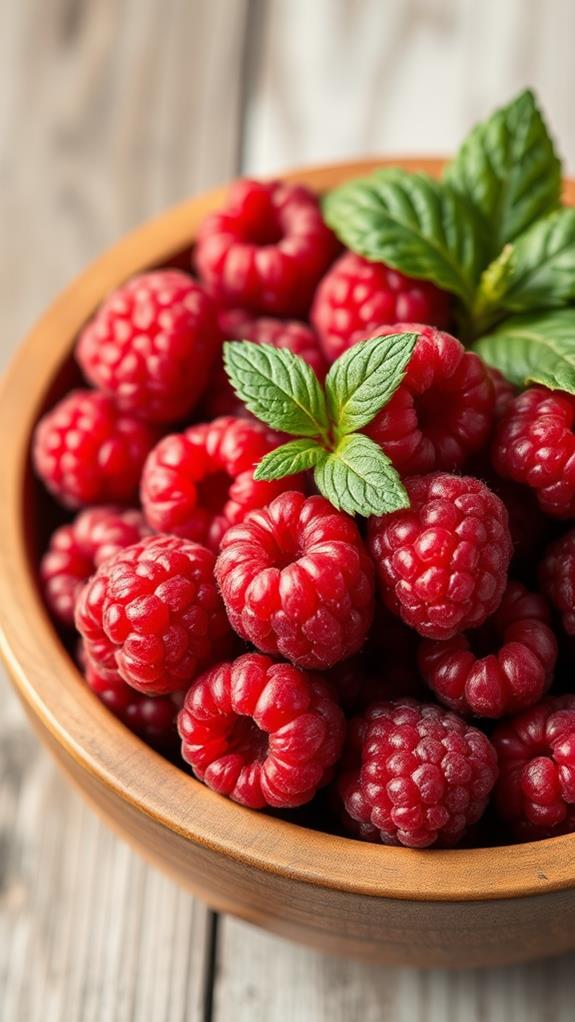
Ripeness plays an essential role in determining the quality and safety of raspberries. When you're selecting these delicate berries, you'll want to look for firm, plump fruits with a deep, vibrant color. Ripe raspberries should easily detach from their core when picked, leaving a hollow center. Just like salmon skin safety, proper handling and storage of raspberries are pivotal to prevent bacterial growth and safeguard food safety.
As raspberries ripen, they migrate from hard and pale to soft and richly colored. You'll notice changes in texture, flavor, and aroma. Perfectly ripe raspberries have a sweet, slightly tart taste and a fragrant smell. They're tender but not mushy, maintaining their shape when gently squeezed.
Understanding the ripening process is pivotal for content creators focusing on SEO-optimized articles about fruit. You'll want to use keywords like "raspberry ripeness indicators" or "how to tell if raspberries are ripe" to improve search engine visibility. Additionally, it is worth noting that overripe raspberries aren't necessarily unsafe to eat, but their quality diminishes. They may develop a softer texture and a fermented taste. If you notice any signs of mold or an off-putting odor, it's best to discard them to avoid potential foodborne illnesses.
Causes of Mushy Raspberries
Several factors can lead to mushy raspberries, and understanding these causes is vital to maintaining the fruit's quality. Overripeness is a common culprit; as raspberries mature, they become softer and more prone to mushiness. You'll notice this if you've left them at room temperature for too long or stored them improperly in the refrigerator. Similar to Brussels sprouts, proper storage is indispensable for raspberries. Effective preparation involves storing them in a breathable container in the refrigerator and consuming them within a week for maximum freshness.
Physical damage is another major cause. Raspberries are delicate, and rough handling during harvesting, transportation, or storage can bruise them, leading to a mushy texture. Moisture is also a significant factor. If raspberries are exposed to excessive humidity or condensation, they'll absorb water and become soggy. This often happens when you store them in airtight containers without proper ventilation.
Mold growth, while less common, can also result in mushy raspberries. Mold thrives in warm, moist environments and can quickly spread from one berry to another. Finally, temperature fluctuations can cause raspberries to break down faster. If you've subjected them to repeated cycles of freezing and thawing, you'll likely end up with mushy fruit. By being aware of these factors, you can take steps to prevent your raspberries from becoming mushy and prolong their shelf life.
Safety Concerns
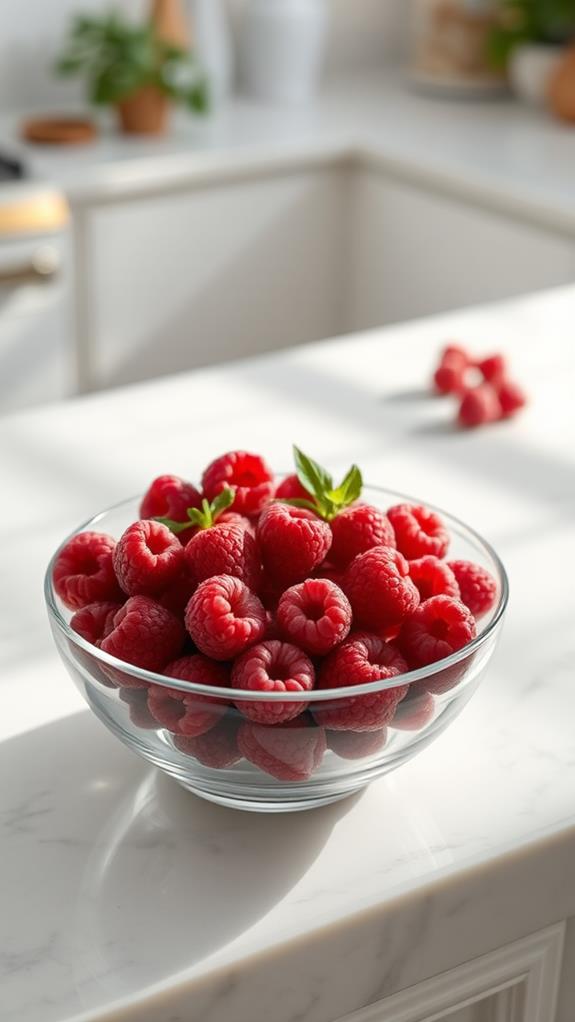
When your raspberries become mushy, you'll want to be cautious about potential safety issues. Soft, overripe berries can become breeding grounds for bacteria, increasing the risk of foodborne illness. While the risks may not be as severe as with undercooked poultry, it's still important to exercise caution. Just as with chicken safety guidelines, proper handling and storage of raspberries are essential to prevent bacterial growth. Additionally, you should watch out for signs of mold or spoilage, which can develop more quickly on mushy raspberries and pose health hazards if consumed.
Potential Bacterial Growth
Occasionally, mushy raspberries can harbor harmful bacteria, posing safety concerns for consumers. As these berries soften and break down, they become more susceptible to bacterial growth. This process creates an ideal environment for microorganisms to thrive, potentially leading to foodborne illnesses if consumed.
When examining your raspberries, be aware of these potential signs of bacterial contamination:
- Mold growth or fuzzy patches
- Unpleasant or fermented odors
- Discoloration beyond normal ripening
- Excessive moisture or sliminess
It's imperative to understand that not all mushy raspberries are unsafe, but they're at a higher risk for bacterial growth. Factors such as storage conditions, handling practices, and the berries' initial quality all play a role in determining their safety. If you're unsure about your raspberries' condition, it's best to err on the side of caution and discard them.
To minimize the risk of bacterial growth, store your raspberries properly in the refrigerator and consume them within a few days of purchase. Avoid washing them until you're ready to eat them, as excess moisture can accelerate spoilage. By following these guidelines, you'll reduce the likelihood of encountering potentially harmful bacteria in your mushy raspberries.
Mold and Spoilage Risks
Beyond bacterial growth, mushy raspberries face significant risks of mold development and spoilage. As the fruit's structure breaks down, it becomes more susceptible to fungal growth. You'll want to carefully inspect your raspberries for any signs of mold, which can appear as fuzzy patches in various colors.
A quick guide to help you identify common mold types on raspberries:
| Mold Color | Appearance | Common Type | Safety |
|---|---|---|---|
| Gray-green | Fuzzy | Botrytis | Unsafe |
| White | Cottony | Rhizopus | Unsafe |
| Black | Powdery | Aspergillus | Unsafe |
| Blue-green | Velvety | Penicillium | Unsafe |
If you spot any of these molds, it's best to discard the affected berries and any that have been in direct contact with them. Mold can spread quickly, producing mycotoxins that may cause allergic reactions or respiratory issues in some people. Even if you don't see visible mold, mushy raspberries are more likely to harbor invisible spores. It's vital to use your judgment and err on the side of caution when deciding whether to consume soft or overripe raspberries.
Nutritional Value
When it comes to mushy raspberries, you'll be pleased to know that their nutritional value remains largely intact. While the texture changes, the fruit retains most of its vitamins, minerals, and beneficial compounds, including antioxidants and fiber. Curiously, the calorie content of mushy raspberries is comparable to that of fresh ones, so you're not sacrificing any dietary benefits by consuming them in their softer state.
Nutrient Retention in Mushiness
Raspberries' nutritional value doesn't markedly decrease as they become mushy. While the texture changes, the nutrients remain largely intact. You'll still benefit from the vitamins, minerals, and antioxidants that make raspberries a nutritious choice. The mushiness might even make some nutrients more bioavailable, meaning your body can absorb them more easily.
As raspberries soften, they retain:
- Vitamin C, essential for immune function and skin health
- Dietary fiber, supporting digestive health and satiety
- Manganese, imperative for bone health and metabolism
- Anthocyanins, powerful antioxidants with anti-inflammatory properties
You might notice a slight decrease in vitamin C content as raspberries age, but this reduction is minimal. The fiber content remains stable, ensuring you still get the digestive benefits. Interestingly, the antioxidant capacity of mushy raspberries can sometimes increase. This is because the breakdown of cell walls can release more compounds that were previously bound. So, while you might not enjoy the texture as much, you're still getting a nutrient-rich fruit that can contribute to your overall health and well-being.
Calorie Content Comparison
The calorie content of mushy raspberries remains virtually unchanged from their firm counterparts. You'll find that a cup of raspberries, whether mushy or fresh, contains approximately 64 calories. This consistency in caloric value is due to the fact that mushiness doesn't alter the basic nutritional composition of the fruit.
When comparing the calorie content, it's crucial to regard the serving size. You might notice that mushy raspberries tend to compact more easily, potentially leading to a higher calorie intake if you're not measuring meticulously. To guarantee accurate portion control, use a measuring cup rather than eyeballing the amount.
It's worth noting that while the calorie content stays the same, the glycemic index might slightly increase in mushy raspberries. This is because the breakdown of cell walls in mushy fruit can make sugars more readily available for absorption. However, this difference is generally negligible in the context of overall nutritional impact.
Consuming Soft Raspberries
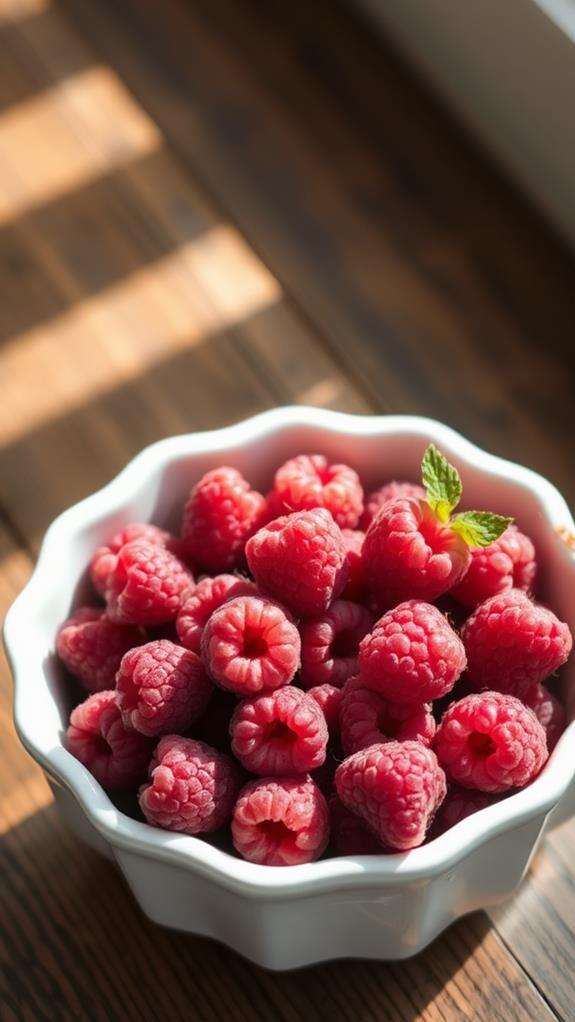
Soft raspberries aren't necessarily hazardous to eat, but they do require careful inspection before consumption. When you're faced with mushy raspberries, examine them closely for signs of mold or excessive bruising. If they appear free from these issues, they're likely still edible, though their texture may not be ideal.
Consider these factors when deciding whether to consume soft raspberries:
- Appearance: Look for discoloration or fuzzy growth
- Smell: Check for any off-putting or fermented odors
- Texture: Assess if they're overly mushy or leaking juice
- Taste: Sample a small piece to guarantee flavor quality
If your raspberries pass these tests, you can still use them in various ways. Blend them into smoothies, incorporate them into baked goods, or cook them down into a sauce or jam. These methods can help mask the softer texture while still allowing you to enjoy the fruit's flavor and nutritional benefits.
Detecting Spoilage
To detect spoilage in raspberries, you'll want to rely on multiple senses. First, examine the berries closely for visual cues like mold, discoloration, or excessive moisture. Next, give them a gentle sniff to check for any off-putting or fermented odors. Finally, assess the texture by gently pressing the berries; they should be firm but not hard, and overly soft or mushy raspberries may indicate spoilage.
Visual Signs of Spoilage
Spotting visual cues is crucial when determining if your raspberries have gone bad. You'll want to examine your berries closely for any signs of deterioration. Look for changes in color, texture, and overall appearance. Fresh raspberries should have a vibrant, deep red color and a slightly fuzzy texture. If you notice any of the following visual signs, it's best to discard the berries:
- Mold growth, which appears as white or grayish fuzzy spots
- Discoloration, such as brown or black patches
- Excessive softness or mushiness
- Shriveled or dried-out appearance
Smell Test Indicators
While visual inspection is important, your nose can also be a powerful tool in detecting spoiled raspberries. Fresh raspberries should have a sweet, fruity aroma. If you notice any off-putting smells, it's a sign that your berries may have gone bad. A sour or fermented odor indicates that the raspberries have begun to decompose, and you shouldn't eat them.
Pay attention to musty or moldy scents, which suggest the presence of fungi. These odors often accompany visible mold growth, but sometimes you'll smell it before you see it. If there's a strong, unpleasant smell reminiscent of rotting vegetation, it's best to discard the berries.
Another indicator is the absence of smell. If your raspberries don't have any scent at all, they may be past their prime. While not necessarily unsafe, they'll likely lack flavor and nutritional value. Trust your olfactory senses; they're finely tuned to detect spoilage. If something smells off, even slightly, it's better to err on the side of caution and avoid consuming the berries. Your nose is a valuable asset in determining food safety, so don't hesitate to use it.
Texture and Firmness
Texture and firmness are key indicators of raspberry freshness and safety. When examining your raspberries, pay close attention to their physical characteristics. Fresh raspberries should be plump, firm, and hold their shape well. If you notice they're becoming soft, mushy, or losing their structure, it's a sign they're starting to deteriorate.
Here are some texture-related signs to watch for:
- Excessive softness or mushiness
- Collapse or flattening of the berry's structure
- Leaking juice or a wet appearance
- Individual drupelets (the small, round sections) falling off easily
As raspberries age, they naturally become softer due to the breakdown of cell walls. However, if they're excessively mushy or falling apart, it's best to avoid eating them. This texture change often indicates that bacteria or mold growth has begun, even if it's not visible to the naked eye. Remember, while slightly soft raspberries are still edible, they won't have the same pleasant texture or flavor as fresh ones. If you're unsure about their safety, it's always better to err on the side of caution and discard them.
Proper Storage Techniques
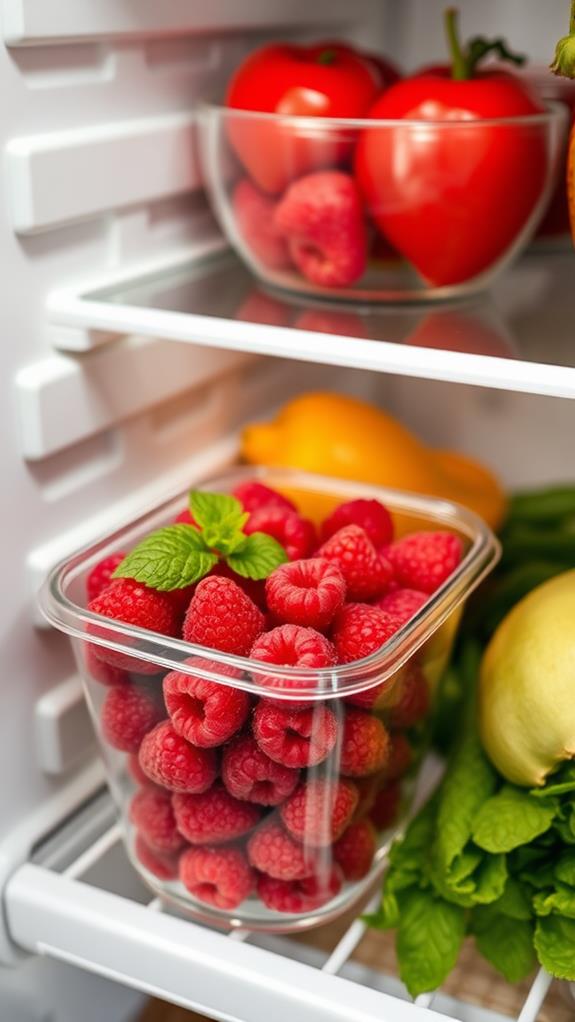
Proper storage techniques are indispensable for maintaining the quality and safety of raspberries. You'll want to store your berries in the refrigerator as soon as possible after purchase or picking. Don't wash them before storing, as excess moisture can accelerate mold growth. Instead, place them in a single layer in a colander or breathable container lined with paper towels. This allows air circulation and prevents crushing.
Your refrigerator's temperature should be set between 32°F and 34°F (0°C to 1°C) for ideal storage. In these conditions, fresh raspberries can last 3-5 days. If you need to keep them longer, consider freezing. Spread washed and dried berries on a baking sheet, freeze until solid, then transfer to an airtight container or freezer bag.
For maximum freshness, you can employ the "first in, first out" (FIFO) inventory method. This SEO-friendly technique guarantees you're using older berries first, reducing waste. Remember, proper storage isn't just about longevity; it's pivotal for maintaining nutritional value and preventing foodborne illnesses. By following these guidelines, you'll extend the shelf life of your raspberries and make sure they're safe to eat.
Salvaging Overripe Berries
Even with the best storage techniques, you might find yourself with overripe raspberries. Don't toss them out just yet! There are several ways to salvage these mushy berries and put them to good use.
Consider these options for your overripe raspberries:
- Blend them into smoothies
- Make homemade jam or preserves
- Bake them into muffins or cakes
- Create a fruity sauce for desserts or savory dishes
When working with overripe berries, you'll want to inspect them carefully for any signs of mold. If you spot fuzzy growth, it's best to discard those berries. However, if they're simply soft and mushy, they're still safe to consume.
To extend the life of your salvaged berries, consider freezing them. Spread them on a baking sheet, freeze until solid, then transfer to a freezer-safe container. This method, known as "flash freezing," prevents the berries from clumping together, allowing you to use small portions as needed.
Preventing Mushiness
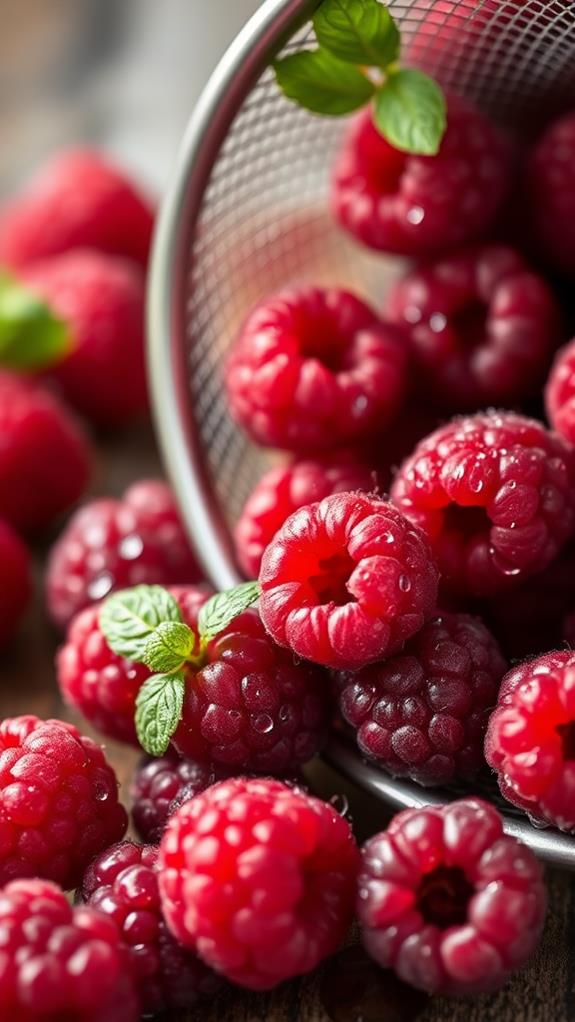
According to experts, the key to preventing mushiness in raspberries lies in proper storage and handling. To keep your berries firm and fresh, you'll want to follow a few simple guidelines. First, inspect your raspberries carefully before purchasing, selecting only those that are plump, dry, and vibrant in color. Once home, don't wash them immediately; moisture accelerates decay. Instead, store them in a breathable container lined with paper towels to absorb excess moisture.
Refrigeration is indispensable, but temperature matters. Set your fridge between 32°F and 34°F (0°C to 1°C) for ideal preservation. This temperature range slows down the ripening process without freezing the berries. You'll also want to keep them away from other produce, as raspberries are highly susceptible to ethylene gas, which speeds up ripening.
For long-term storage, consider freezing. Spread the berries on a baking sheet, freeze until solid, then transfer to an airtight container. This individual quick freezing (IQF) method prevents clumping and maintains berry integrity. By following these steps, you'll markedly extend the shelf life of your raspberries and reduce the likelihood of mushiness.
Alternative Uses
While mushy raspberries might not be ideal for eating fresh, they still have plenty of uses in the kitchen. You can repurpose these overripe berries in various ways, ensuring they don't go to waste. One popular option is to make a delicious raspberry sauce or coulis. Simply blend the mushy raspberries, strain out the seeds if desired, and cook with sugar to create a versatile topping for desserts or breakfast items.
Another great use for mushy raspberries is in baked goods. You can incorporate them into muffins, cakes, or bread recipes for added moisture and flavor. They're also perfect for making homemade jam or preserves. If you're looking for healthier options, consider using mushy raspberries in:
- Smoothies or protein shakes
- Homemade popsicles or frozen yogurt
- Fruit leather or fruit rollups
- Infused water or flavored iced tea
Frequently Asked Questions
Can Mushy Raspberries Be Used to Make Jam or Preserves?
Yes, you can definitely use mushy raspberries to make jam or preserves. In fact, they're often ideal for this purpose. Overripe berries are softer and release their juices more easily, which can lead to a smoother, more flavorful spread. You'll want to remove any moldy berries, but the rest can be cooked down with sugar and pectin to create delicious jams. This process also helps preserve the fruit's nutrients and flavor, giving your mushy raspberries a second life.
Do Mushy Raspberries Have a Higher Sugar Content Than Firm Ones?
You might assume mushy raspberries have more sugar, but that's not necessarily true. As raspberries ripen, their sugar content typically remains stable. The mushiness is often due to cell wall breakdown, not increased sugar. However, the perception of sweetness may change as the fruit softens. This is because the breakdown of cell walls can release more juice, making the existing sugars more noticeable to your taste buds. So, while not actually sweeter, mushy raspberries might taste sweeter to you.
Are There Any Health Benefits Specific to Overripe Raspberries?
You might think overripe raspberries are past their prime, but they've got some hidden perks. While their texture isn't ideal, these mushy berries can have higher levels of antioxidants, particularly anthocyanins, which increase as the fruit ripens. They're also softer, making them easier to digest and potentially more beneficial for your gut health. Additionally, overripe raspberries may have a slightly higher sugar content, providing a quick energy boost. However, it's crucial to ascertain they're not moldy before consuming.
Can Mushy Raspberries Be Frozen for Later Use in Smoothies?
Yes, you can freeze mushy raspberries for later use in smoothies. It's a great way to salvage overripe fruit and reduce food waste. Simply rinse the berries, pat them dry, and spread them on a baking sheet to freeze individually. Once frozen, transfer them to an airtight container or freezer bag. They'll keep for up to 6 months. When you're ready to use them, just toss the frozen berries directly into your blender. They'll add flavor and a cool, slushy texture to your smoothies.
Do Different Raspberry Varieties Become Mushy at Different Rates?
Yes, different raspberry varieties do become mushy at different rates. You'll find that some cultivars, like Heritage or Autumn Bliss, tend to hold their shape longer than others. Factors such as sugar content, cell structure, and moisture levels play a role in how quickly raspberries soften. Environmental conditions, including temperature and humidity, also affect the rate of mushiness. To keep your raspberries firm longer, you should store them properly in a cool, dry place and avoid washing them until just before use.
Conclusion
As you've learned, mushy raspberries aren't necessarily unsafe, but their quality and taste may be compromised. You'll need to inspect them carefully for signs of spoilage. While they might not be ideal for fresh eating, you've discovered various ways to salvage and use overripe berries. Remember, proper storage is key to maintaining freshness. By applying these insights, you'll be better equipped to handle your raspberries, ensuring both safety and enjoyment. The choice is yours: Will you risk that slightly soft raspberry?





